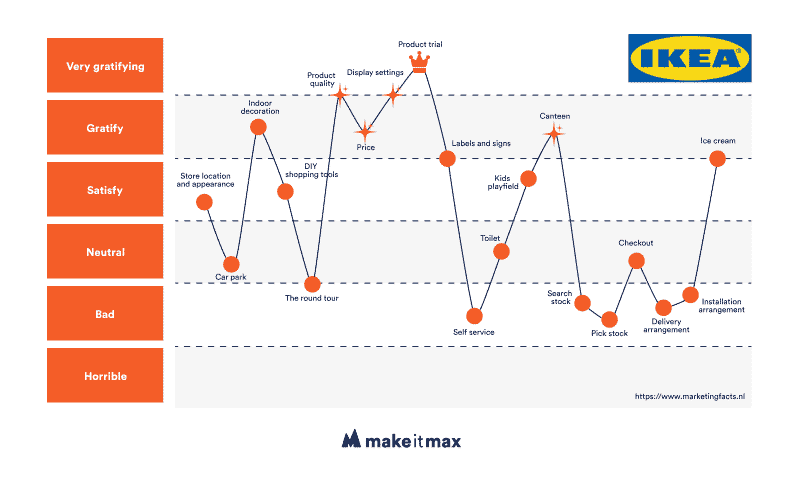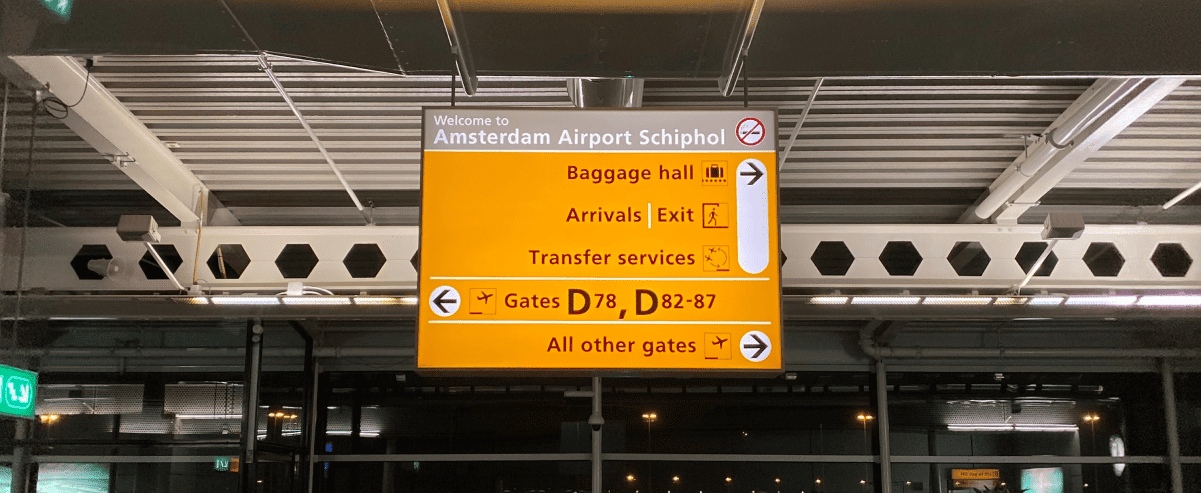What is customer journey mapping?
A customer journey map shows you which touchpoints and decisions users encounter while interacting with a brand or product. While most user experience methods are focused on the experience of a user while using the product, a customer journey map involves all the other interaction points, including thoughts, feelings and more. From the first encounter with a brand and becoming conscious about it, to customer care after a product is used.
A customer journey map is quite comprehensive and includes different kinds of information. Let’s have a look at an example for the specifics:

It’s called a map because it has a clear start and finish, like going for a walk in the park or on the beach! 🙂
Generally, a customer journey map includes the following:
- Actions: describe what a user is doing and consists of verbs like walking, seeing, touching, grabbing, buying, calling, sipping (from delicious cocktail), etc.
- Touchpoints: are the different branding tools a user encounters, for example a poster, billboard, product, website or social media. But also spaces, like a store, subway, under a palm tree or an office.
- Thoughts: include what the user is thinking when doing a certain action. This includes motivations, wants and needs.
- Emotions: not to be confused with thoughts, are what a user is feeling, like happiness, confusion or frustration. To clarify the difference, this part can be visualized through emoticons or a graph.
- Pains & gains: clarify the changes or improvements a business can make to their product or branding. It’s the take-away from the information stated above and it describes the opportunities for an improved user experience.
Depending on the product, it can include other elements, like a summary of the user persona, the devices a user uses during the journey, the backend process and expectations of the user.
Why do we use customer journey mapping?
While most UX methods focus on the experience of the product only, a customer journey map includes all interactions with a service or product and brand. Because UX design is intertwined in the whole process of making and improving a product, it has a lot in common with other disciplines, like marketing, copywriting and sales. This is a perfect way to join forces because eventually we all have the same goal: to create or improve a great product!
It’s no longer enough to ‘just’ make an enjoyable, easy-to-use product. You need to get the whole thing right! So, to get a complete insight of the user experience, the whole journey must be mapped (hence ‘customer journey mapping’). It allows you to determine if a product needs adjustments, besides to the product, in other parts of the branding as well to improve the user experience as a whole.
As you can see, making an enjoyable and easy-to-use product is merely one step of a much bigger journey to a great user experience and to achieve more sales.
How and when do we use customer journey mapping?
Let’s say you have a product with all the branding around it. You communicate on different platforms, on- and offline, to promote that product. You have billboards, magazine ads, tv-commercials, online ads on Google and Amazon, and so on. You want to know which of these investments have the highest ROI (return of investment), for example, and how to target your audience better.
To gain the most insightful information, you want to create different persona’s based on your target audience. With these persona’s, a customer journey map can be created to see how the different target audiences experience your brand throughout the whole ride.
A report with these insights will show you where the pain points currently lie and what should be done next to turn them into opportunities. Now you have a clear direction on where to go next and how to perfect your brand experience.
When should you make a customer journey map?
- If you want to understand your users better.
- Your ROI isn’t as high as you would like, but you are unsure how to improve it.
- You have improved your digital product (e.g.: website, platform or app) and you want to know if there are other pain points that need to be addressed.
- You want to make valuable changes to your brand experience but you don’t know where to start.
The perfect customer journey map example
If you really want to get our UX designer hearts racing, ask us about IKEA’s customer journey map! The people at IKEA have amazing valuable insights on how their users experience the shopping routine from beginning to end.

IKEA’s customer journey map focuses on the literal journey from entrance to exit. You can see several peaks and lows during a typical visit; from being very happy about the product quality, to being annoyed about the self-service.
But, what we believe is the most brilliant thing about IKEA, are definitely the very affordable hotdogs and ice cream at the very end of the journey. IKEA actually loses money over this, but it’s more than worth it when everybody leaves happy and fulfilled no matter how annoyed they were earlier. I know I would!
IKEA believes that customers don’t have to remember the whole experience, and by ending the visit on a happy note, IKEA’s customers are likely to return.
The takeaway
Now you know all about customer journey mapping, the why’s, the how’s and the when. It’s no secret that we can get carried away with great examples, but we would much more like to tell you in person. So give us a call and we’ll talk about your business and how a customer journey map can make all the difference in your success-story! Under a palm tree of course. 🙂






0 Comments